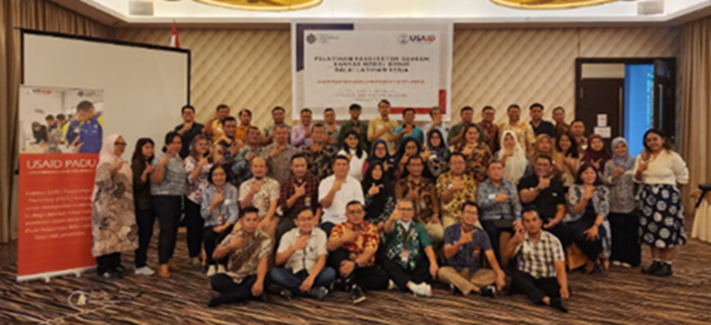Building Collaboration Among Public and Private Sector Workforce Development Stakeholders in North Sumatra
The Partnerships for Productivity (PADU) Activity funded by the United States Agency for International Development (USAID), has trained 50 officials in Indonesia’s North Sumatera Province (21 women and 29 men) to facilitate Business Model Canvas (BMC) for government-run Technical and Vocational Education and Training (TVET) institutions.
The BMC is a strategic management and entrepreneurial tool that allows users to describe, design, challenge, invent, and pivot their respective business models. The 50 trained officials serve as facilitators in the development and implementation of joint action plans across government agencies at the provincial and district levels to address workforce and unemployment concerns. One of the facilitators was Mr. Syamsul Adha, a Secretary in the Industrial and Trade Office Langkat District in North Sumatera.

Prior to being a facilitator of BMC for government-run TVET institutions, Mr. Adha’s job was to provide support to various small and medium-sized firms through market-related innovation, and to guarantee that they met the government’s best practices and requirements. He had hoped to work on multi-sector projects that would improve the quality and efficiency of small and medium-sized businesses. Mr. Adha’s superior requested that he participate in the Design Thinking and BMC Training of Trainers for North Sumatra Facilitators hosted by USAID PADU and the MoM Directorate General of Vocational Training and Productivity (Binalavotas).
One of the most significant things Mr. Adha learned from the course was that coordination and teamwork require a lot of communication, trust, and respect. He stated the training mentor highlighted how different departments and agencies have distinct aims, perspectives, and agendas, and that they frequently clashed with one another. “My office and district BLK have different objectives. However, we have the same overarching goal: reducing unemployment. To achieve our objectives, we must work together effectively,” Mr. Adha stated.
Another takeaway from the course for Mr. Adha was that coordination and collaboration are multi-faceted. He stated that other departments and agencies need to feel like they are part of the solution, not the problem. Further, to successfully coordinate and collaborate, one must involve them in the planning, implementation, assessment, and improvement of projects and initiatives.
“I am very pleased with the training, and I am able to formulate my ideas and present them to a large number of participants,” Mr. Adha stated. Thanks to the training, his ambitions have grown, and he wants to serve more people in the Langkat District of North Sumatra Province, particularly the job-seeking youth. He is also now more confident in launching a joint approach among government entities to address unemployment.
This successful first training using the BMC model paves the way for future PADU activities, while initiating important communication and trust linkages between private and public entities to better inform future technical assistance activities. The BMC training allowed participants to learn how to frame problems, solve them, and provide constructive criticism to their colleagues in the hopes of achieving mutually beneficial goals. The Indonesian Ministry of Manpower (MoM) will use these communication tools for co-design and collaboration with TVET institutions and private sector entities, while PADU provides critical support for these collaboration efforts to achieve its objectives.
